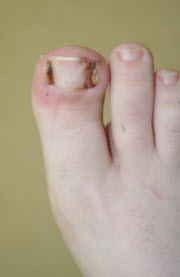Ingrown Toenails In Children
Definition
An ingrown toenail is the penetration of the side or corners of the nail in to the skin on one or both sides of the nail. Any toenail can become ingrown, but ingrown toenails usually occur in the big toe. The medical term for an ingrown toenail is Onychocryptosis.

Symptoms
- Pain along the margins of the nail where the nail is penetrating the skin along the margins of the nail
- Sensitivity to pressure applied to the surrounding area
- Swelling around the affected area and a warm sensation may be felt
- Nail may become hard
- In case of infection there may be bleeding along with a discharge of fluid
Causes
- Wearing tight footwear (nail presses against the skin)
- Cutting nails too short or unattended edges of the nail
- Injury / trauma to the nail like stubbing the toe or dropping something heavy on the toe
- Fungus infection - causing the nail to harden which makes it easier to penetrate the skin
- Sweaty feet - causing skin to soften which makes it easier to penetrate the skin
- Structure of the nail, highly curved nails which may be hereditary
Risks
Besides causing pain and discomfort, if the ingrown nail is not attended to, it may lead to infection or even an abscess that requires surgical treatment. Osteomyelitis is a rare complication of an infected toe, in which the bone itself becomes infected.
Prevention
- Wear well fitted shoes (Avoid wearing tight and pointed footwear)
- Maintain good foot hygiene
- Keep feet dry
- Cut nails without leaving pointed corners. The recommended way to cut nails is to cut straight across. Avoid cutting the nail along a curve and avoid cutting the nails too short. Try and cut the nail in line with the skin around it or keep it slightly longer than the skin edge.
Treatment
Depending on how severe the condition is, treatment types may vary. For moderate cases,- Soak the foot in warm water and an antibacterial ointment
- Then try and lift the edge of the nail that is digging into the skin and place a hand rolled cotton or gauze wick of appropriate size between the nail and the skin to keep the nail elevated. Change the wick daily. Repeat this for approximately two weeks for the nail to grow so that it does not dig into the skin any longer. If you are not comfortable with trying this, consult a Podiatrist.
- Avoid wearing tight footwear
If the above does not show any sign of improvement, consult a Podiatrist (Foot specialist). For severe cases, the offending area of the nail may need to be surgically removed by a Podiatrist. At medifoot clinic, we have proven success in treating ingrown toenails.

